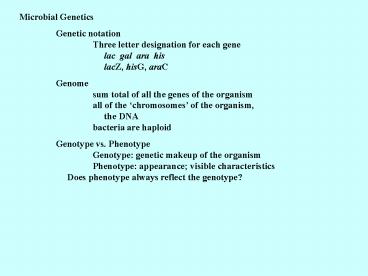Microbial Genetics - PowerPoint PPT Presentation
1 / 33
Title:
Microbial Genetics
Description:
lysogenic or temperate phage. Transduction. Bacteriophage or ... Generalized transduction lytic or lysogenic phage. any suitably sized piece of DNA packaged ... – PowerPoint PPT presentation
Number of Views:82
Avg rating:3.0/5.0
Title: Microbial Genetics
1
Microbial Genetics Genetic notation Three
letter designation for each gene lac gal
ara his lacZ, hisG, araC Genome sum
total of all the genes of the organism all of
the chromosomes of the organism, the
DNA bacteria are haploid Genotype vs.
Phenotype Genotype genetic makeup of the
organism Phenotype appearance visible
characteristics Does phenotype always
reflect the genotype?
2
Microbial Genetics Gene - unit of
inheritance structural gene - information for a
protein regulatory gene - control protein
formation operon structural genes plus
regulatory genes
3
Recombination bringing new gene
combinations together Eukaryotes - crossing over
during meiosis reciprocal exchange Prokaryotes
- transfer of genes from one cell to
another one-way transfer of genes DNA
transferred exogenote recipient DNA
endogenote partial diploid may be formed
Transformation Conjugation
Transduction Limited transfer one gene
to a few genes closely related cells
4
Transformation Griffiths, 1928 - vaccine for
pneumonia Streptococcus pneumoniae smooth vs.
rough strains transforming principle Avery,
McCarty MacLeod, 1944
5
Transformation naked DNA released by cell
binds to competent recipient cell competence
is physiological state competence requires
protein synthesis DNA binding protein on
cell surface receptor DNA must be dsDNA
of suitable size (450-15,000 bp)
6
Transformation naked DNA released by cell
binds to competent recipient cell competence
is physiological state competence requires
protein synthesis DNA binding protein on
cell surface receptor DNA must be dsDNA
of suitable size (450-15,000 bp) one
strand degraded ssDNA enters cell pairs
with genome heteroduplex formed by
recA
7
Heteroduplex DNA mediated by recA
8
Conjugation Lederberg Tatum, 1946
auxotrophs in E. coli auxotrophs mixed
108 cells plated on minimal medium
reversion vs. ? shown cell contact
required
9
Conjugation Cell contact required
10
Conjugation Hayes, et. al., 1950s transfer
one-way, not reciprocal donor and recipient
strains ( and strains) donor F
recipient F- mating of F x F- ? 2 F F
is F plasmid bacterial gene transfer rare
11
Conjugation Hayes, et. al.,
1950s discovered family of mutants with a high
frequency of recombination Hfr
mutants no conversion of F- in mating
bacterial gene transfer high plasmid integrated
into host genome specific locus
cross-over
12
Conjugation Pilus needed for cell contact
DNA synthesis needed for transfer rolling
circle replication begins at origin (ori) one
strand nicked
13
Conjugation F x F- Hfr x F-
14
Conjugation Plasmid exit from genome Hfr ?
F Hfr ? F'
15
Conjugation Plasmid exit from genome Hfr ?
F Hfr ? F' recipient is a
partial diploid
16
Mapping the bacterial genome Hfr transfer of
bacterial genes
17
Mapping the bacterial genome
18
Transduction Bacteriophage or phage -
bacterial viruses lytic or virulent phage
lysogenic or temperate phage
19
Transduction Bacteriophage or phage -
bacterial viruses lytic or virulent phage
lysogenic or temperate phage
20
Transduction Bacteriophage or phage -
bacterial viruses lytic or virulent phage
lysogenic or temperate phage Bacterial DNA
transfer Generalized transduction Restricted
transduction
21
Transduction Generalized transduction
lytic or lysogenic phage any suitably sized
piece of DNA packaged
22
Transduction Restricted transduction only
genes adjacent to insertion site phage ?
- att locus gal or bio loci
23
Transduction Restricted transduction only
genes adjacent to insertion site phage ?
- att locus gal or bio loci phage
defective ?dgal requires helper phage
24
Transduction Restricted transduction only
genes adjacent to insertion site phage ?
- gal or bio loci phage defective ?dgal
requires helper phage
25
Fates of DNA Incorporation of genes
transformation, conjugation, transduction
26
Fates of DNA Incorporation of genes
transformation, conjugation, transduction Persist
and replicate - clone of cells with the DNA
self-replicating plasmids
27
Fates of DNA Incorporation of genes
transformation, conjugation, transduction Persist
and replicate - clone of cells with the DNA
self-replicating plasmids Persist but not
replicate abortive transduction
28
Fates of DNA Incorporation of genes
transformation, conjugation, transduction Persist
but not replicate abortive
transduction Persist and replicate - clone of
cells with the DNA self-replicating
plasmids Degradation or host restriction
29
Fates of DNA
30
Host restriction restriction
endonucleases cut at specific nucleotide
sequences 6-8 base pairs most generate sticky
ends
31
Restriction enzymes EcoRI
32
Host restriction restriction
endonucleases cut at specific nucleotide
sequences 6-8 base pairs most generate sticky
ends host DNA protected by
methylation -G-A-A-T-T-C- -C-T-T-A-A-G-
33
Genetic engineering Tools vectors - plasmids,
bacteriophage restriction enzymes Products pr
oteins - see Table 9.2 in text resistant
plants































